Accelerate Success with AI-Powered Test Automation – Smarter, Faster, Flawless
Start free trialSoftware testing has evolved rapidly over the last few decades. The transition from manual testing to automation testing was one of the key turning points in the history of software testing. When Selenium was first introduced in the early 2000s, it immediately gained popularity and became one of the most favoured tools for test automation. However, it came with a condition that the testers need to have knowledge of programming in order to reap maximum benefits from test automation. So, even though automation was supposed to “reduce” the testing workload, the testers ended up spending a lot of time writing code scripts for testing.
With the rising demand for efficient software with faster time to market, software testing became even more stringent. Automation, though helpful, came at a price in terms of resources and time. The year 2020, heralded the era of codeless testing, which ensures a high-quality deliverable while reducing the testing time significantly.
What is Codeless Testing?
Codeless testing essentially means conducting automated testing without writing a code for the test script.
Codeless testing addresses the issues of regular test automation i.e.
- The steep learning curve for testers
- Mandatory to know to program
- Zeroing on a suitable programming language to use
- Extra time consumed in debugging in case there is a bug in the test script itself
- Test case management is difficult in case of multiple changes
With Continuous testing being an integral part of the CI/CD process, the testing task becomes repetitive and time-consuming. Codeless testing accelerates the overall testing process, with a significant reduction of burden from the development and QA teams.

What Makes Codeless Testing Special?
Most codeless testing tools are built on top of Selenium and have a plethora of inbuilt features which aid the testing teams. The test engineers can leverage the power of these tools to conduct testing efficiently. Let us take a look at the benefits attached with codeless testing.

Easy to Conduct with Minimum Learning
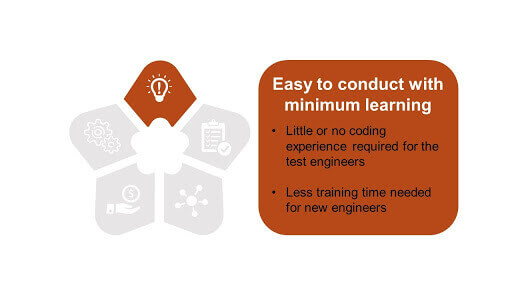
Codeless testing enables test engineers with little or no programming knowledge to create, execute and maintain the test cases without investing time in learning to code. This not only saves a lot of time and efforts but also makes the whole testing process much more efficient.
Efficient Test Case Management
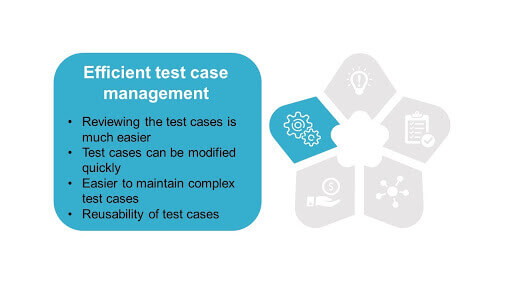
Earlier, a major chunk of time was spent in writing and reviewing the test scripts. Needless to say, it required a specific skill set too. With codeless testing, this is no longer a hurdle. The test engineers can generate test cases easily. Also, the non-technical stakeholders can easily understand the test cases and give their feedback.
Any modifications in the functionality can be quickly incorporated, thus increasing the reusability and maintainability quotient of the test cases. Usage of AI/ML in managing, maintaining, healing and executing the test suites, with little or no human intervention is the way forward.
Resource Saving
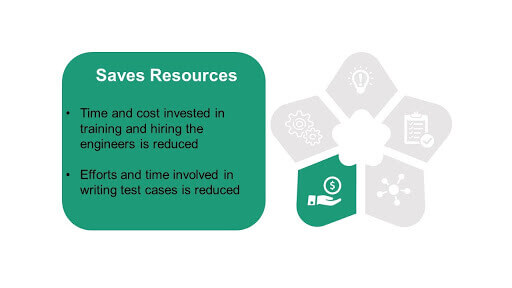
Hiring the right fit for a testing job used to be a challenge. A candidate had to “know” coding besides having a thorough knowledge and good experience in testing. A lot of time and energy was spent looking for that perfect match. Codeless testing eases the burden of programming know-how.
Continuous testing, though a good process to incorporate, comes with its own baggage. The test engineer ends up spending a lot of time in regression testing, that there is little time left for important aspects like exploratory testing, which sometimes becomes a hurriedly done activity. With codeless testing, efforts and time involved are reduced, thus freeing up the major resources to focus on other important aspects of software development and testing processes.
In Sync with CI/CD/CT Cycle Pace
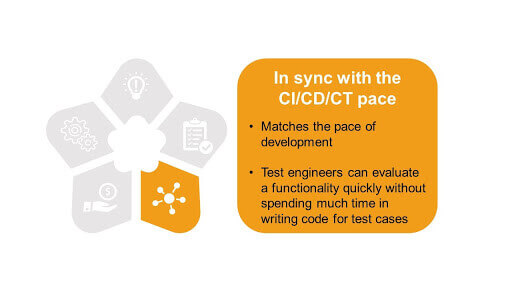
Codeless testing ensures that the testing does not become a bottleneck in CI/CD pipeline. It spurs the whole process by quickly generating the test cases and effortlessly addressing any modifications during the course of testing.
Rapid Reporting and Analysis
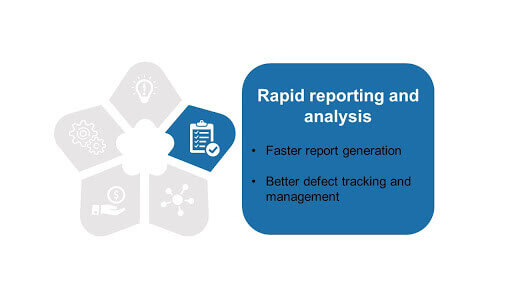
Results of testing need to be shared across the board for evaluation for all success and failures. Codeless testing results are recorded as test logs and video logs for quick reference. This aids all the stakeholders in analyzing the results for working on and improving their test strategy for upcoming test cycles.
Defect rectification and re-testing becomes much easier with codeless testing. Test engineers can conduct multiple test runs without worrying about modifying long lines of code.
Conclusion
Codeless testing bridges the gap between the skill-set requirements and high-quality testing. The teams can now focus on the value and outcome of testing, leading to meeting the demand of shorter delivery cycles. However, it is extremely important to choose the right testing tool which seamlessly integrates into the current CI/CD pipeline and also provides effective automation which leverages the power of AI/ML.
Webomates CQ provides the codeless testing solution that works in 2 phases:
- Creation: Test case creation is much easier for the test engineer, as coding expertise is no longer a constraint. Once the test strategy is decided, our AI discovery & generation tool generates not only test scripts that are compatible with multiple automation frameworks, but also human-readable test cases for review, which makes a review of the tests much easier for the testers. This saves precious time and resources.
- Execution & Analysis: Webomates AI codeless engine effortlessly modify (heal) the test cases, scripts and re-executes them as per the changes in the features or as per the bug fix. It eliminates the false failures and noise so the stakeholders can just focus on fixing the defects found in the system.
Generally, test case maintenance is a herculean task but with Webomates CQ it is a hassle-free activity and happens within the guaranteed execution SLA. Updating the test cases scripts and maintaining them is not so difficult any more, as the AI engine is responsible for doing it for you.
Detailed defect triage reports and videos are shared across the board, which makes it easier for all the stakeholders to analyze and work on their strategies.
At Webomates, we continuously work to evolve our platform and processes, in order to provide guaranteed execution, which takes testing experience to an entirely different level, thus ensuring a higher degree of customer satisfaction.
If this has piqued your interest and you want to know more, then please click here and schedule a demo, or reach out to us at info@webomates.com. If you liked this blog, then please like/follow us Webomates or Aseem.
Tags: Codeless Test automation, Codeless Testing, What Is Codeless Testing


Leave a Reply